"During the floor debate this morning over the historic American Clean Energy and Security Act (ACES), Rep. Paul Broun (R-GA) received a round of applause from GOP colleagues when he claimed that man-made global warming is a 'hoax' with 'no scientific consensus.'' ThinkProgress, June 26, 2009
One of the great ironies of our age is that skepticism of global warming is treated with greater respect than, say, Holocaust denial. Equally remarkable is how little people know about the basic numbers of climate change. If you understand how compound interest works, you can understand the urgency of facing the issue today.
CO2 Never Goes Away (At Least Not for 100 Years) - England no longer burns the soft sulfuric coal that poisoned the lungs of Londoners in the Great Smog of 1952, which killed 4,000 people in five days. Though the toxins may be gone, the carbon dioxide emitted in Britain and everywhere else in the 1950s remains in our atmosphere today.
Carbon dioxide, or CO2, accounts for 85 percent of all greenhouse gas emissions. As you may remember from high school biology, CO2 is absorbed by plant life as an essential part of photosynthesis. Also, CO2 dissolves in water, which is why the ocean absorbs a lot of it, over time. But after plants and the ocean have absorbed all they can absorb, the remaining CO2 remains in the atmosphere, for about 100 years. We have been generating a CO2 surplus since the dawn of the Industrial Revolution.
This is why the average CO2 count rises every year. (Within a single year, the CO2 count rises and falls according to the weather or the seasons.) Even if we cut back on the essentials of modern society - thermal power plants and motorized transportation -the CO2 count will continue its compound growth.
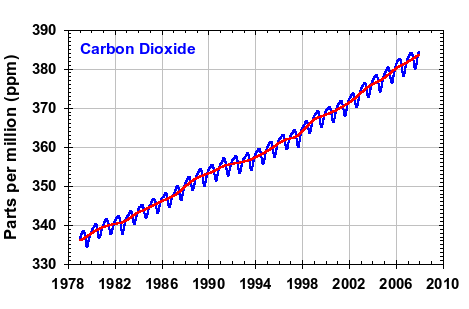
CO2 Heats Up The Atmosphere - Everyone understands how CO2 reacts in the atmosphere. CO2 absorbs the sun's infrared waves. This infrared radiation makes the CO2 molecule unstable. The molecule can only return to its stable state by emitting the thermal radiation back into the atmosphere.
Bottom Line Syllogism on CO2 -Because more CO2 remains in the atmosphere, and because CO2 in the atmosphere generates atmospheric heat,more atmospheric heat is being generated.
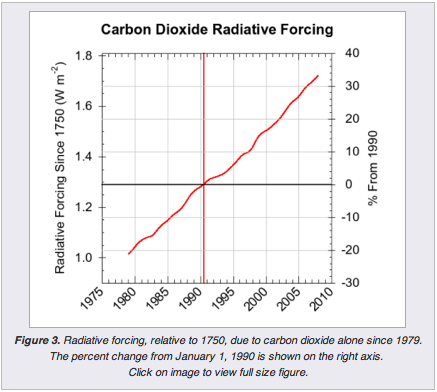
This is why global warming is an absolute certainty.
There is some debate as to whether we have passed an irreversible threshold. James Hansen, NASA's climate expert profiled in The New Yorker, says that a massive climate disaster can only be averted if the CO2 count never reaches above 350 parts per million, a level we surpassed in 1987. Others say the threshold is 450 parts per million. We are currently at 385 parts per million.
The Compound Growth of CO2 Emissions - While the atmospheric growth of CO2 is inevitable, the modern world keeps increasing the level of CO2 emissions produced every year. The U.S. Energy Information Agency predicts that annual global CO2 emissions from fossil fuels will continue to grow significantly into the next decade.
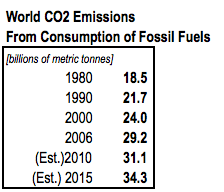
As you would expect, most of the CO2 in the atmosphere represents the historical legacy of the developed world. Between 1980 and 2000, about half the CO2, from the consumption of hydrocarbons, came from the United States, Europe and Japan. China generated only 11 percent.
The Problem Requires the Leadership of the United States and China - China's economic growth has exacerbated the threat of climate change. About 59 percent of the growth in CO2 emissions between 2000 and 2006 came from China, which has overtaken the United States as the largest producer of greenhouse gas emissions.

This makes things tricky. Since close to half of all greenhouse gas emissions come from the United States and China, both countries must take the lead in finding a solution to the problem. But China's increased fuel consumption has operated in tandem with its double-digit economic growth, which has been an engine for growth throughout the globe. And our financial recovery depends on China's willingness to continue buying Treasuries at fairly low yields.
The United States emits, on a per capita basis, greenhouse gases at about twice the rate of any other major economy. So, from the vantage point of the rest of the world, C02 cutbacks imposed on Americans might offer the biggest bang for the buck, with comparatively minor hardship. It's hard to see how we can ask for China's forbearance without demonstrating our willingness to make concessions at home.
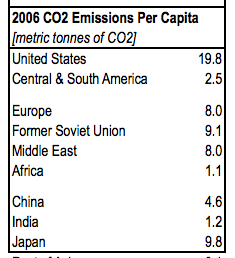
Substituting Gas for Coal Shows the Quickest Results - There are many proposed solutions to the threat of climate change: nuclear power, geologic sequestration, smart grids, electric cars, and others. They entail massive investment in infrastructure over the span of many years. What can be done now?
In the United States, the quickest, and most effective way to cut back on greenhouse gas emissions is to use natural gas as a substitute for coal in electricity generation. Coal-fired plants emit about 2.4 times the CO2 as gas-fired plants (more specifically, coal emits 1.9 times the CO2 per energy unit, and gas-fired plants are about 1.3 times as fuel efficient as coal-fired plants).
Coal represents about 40% of our CO2 emissions. When people use the phrase "clean coal," they are generally referring to technologies that trap toxins like nitrous oxide, not CO2. The one technology for trapping CO2, geologic sequestration, would require a massive capital expenditures for an untested technology.
The global consumption of coal is concentrated in two countries: the United States and China. China's consumption of coal has doubled in the past five years. Again, if we want China to cut back on its use of coal, we need to take the lead.
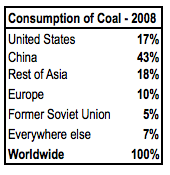
The United States Has Abundant Gas and Gas-Fired Generating Capacity - Thanks to advances in technology, the U.S. supply of natural gas available for production has increased 58% in the past four years.
As it happens, we also have a lot of gas fired electrical power plants that operate only a small fraction of the time, whereas coal fired plants tend to operate at full capacity continuously. Almost half of our electricity comes from coal, while only 21 percent comes from natural gas, even though our gas-fired generating capacity exceeds our coal-fired capacity.
The buildup of gas-fired generating capacity began in the late 1990s, when the electric power industry deregulated in many states. Gas-fired capacity more than doubled between 1999 and 2005, while coal-fired capacity has been flat since the early 1990s. There are many economic reasons why developers preferred gas-fired plants over coal. Gas fired plants are much cheaper to build and easier to operate (think of modern desktop computers versus vintage mainframes).
The gas-fired building boom turned into a bust, because investors had relied on two incorrect assumptions. They assumed that coal-fired plants and nuclear plants would operate at their historic capacity levels. In fact, after utilities sold their coal and nuclear plants to private developers, as part of the deregulation process, coal and nuclear generation increased markedly. Between 1997 and 2002, nuclear generation increased by 24%. Between 1997 and 2004, coal generation increased by 7%.
Coal plants are dispatched to operate more frequently than gas plants because of their relative marginal operating costs, which is primarily the cost of fuel. Coal is much cheaper than gas. The cap-and-trade legislation before Congress was originally intended to provide Americans an economic incentive to use more gas and less coal.
According to James Hansen and others, the legislation is grossly inadequate. But the likelihood rejection of this minor level of adjustment shows the magnitude of our collective denial.
Addendum: Some of the comments below have questioned whether CO2 has been growing at a compound rate and whether clouds have a bigger impact than CO2 on the environment. From "Changes in Atmospheric Constituents and in Radiative Forcing," by the IPCC are two graphic illustrations of the scientific consensus on those points.
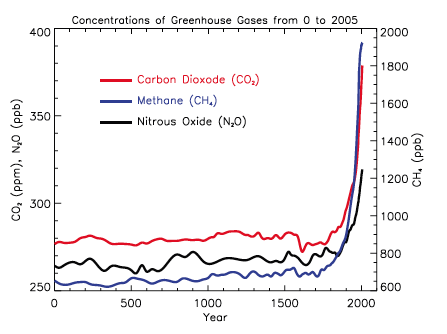
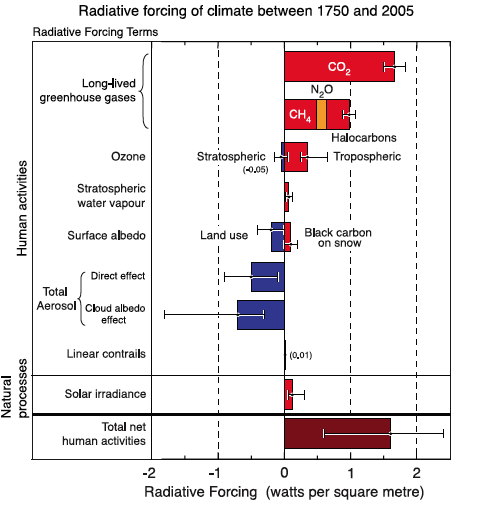
2nd Addendum, July 1, 2009: Some of the comments below presented an eye-opening look into the relentlessness of global warming deniers. For a definitive refutation, see Scientific American's interview with NYU's Tyler Volk, who wrote CO2 Rising: The World's Greatest Environmental Challenge:
"[T]here are thousands of scientists involved in this IPCC [International Panel on Climate Change] effort. So even though it is funded by the U.N., there are thousands of scientists involved and scientists are [a] pretty competitive, contentious bunch and there's a lot of young scientists that could make their names by proving the other findings for the last decades wrong; and so the fact that these predictions of warming and run by a dozen different models all over the world, any one of which would love to prove that the other models are wrong, you know, we have to see science as a kind of an evolutionary process in terms of variation and natural selection...So this self-correcting of a process, I mean, there is debates about the actual impacts of the CO2 on climate; but what I am trying to do in the book is to get people to understand the carbon cycle, ... even though the details of the warming are not known, the fact that it will warm and will make effects. It is enough and that really is an established scientific fact."